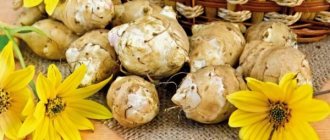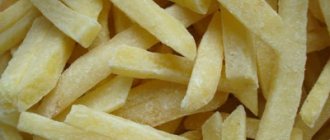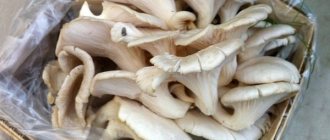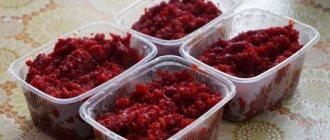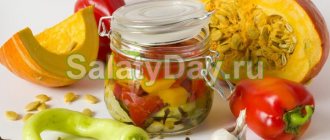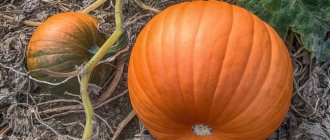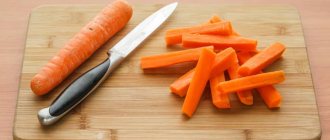Pumpkin is not only a mandatory Halloween attribute, but also a healthy vegetable that contains many substances necessary for the human body.
Ascorbic acid, which is part of the vegetable, will boost immunity, rare vitamin T will help normalize digestion, prevent anemia, vitamin K will strengthen the skeletal system.
In addition, the orange vegetable is rich in vitamins A, D, E, F, PP, calcium, phosphorus, potassium, iron, fiber and plant sugars. Thanks to this, they try to preserve the pumpkin for the winter using various methods.
For example, they store it in the cellar, dry it, dry it, and even preserve it. Many people are interested in the question: is it possible to freeze pumpkin in the freezer? Of course, it is possible and even necessary. But we will describe in detail below how to properly freeze vegetables for the winter.
How to prepare a vegetable for freezing?
The main thing when preparing pumpkin for the winter is to select and prepare the vegetable for freezing. To do this, several factors are taken into account:
- Any type of vegetable can be frozen. However, the best varieties are considered to be: Acorn, Harlequin, Butternut, Divo, Gribovskaya, Khersonskaya, Gileya, Bylinka, Muscatnaya.
Attention! Summer pumpkins (light and soft) are more suitable for later preparing soups, manti and adding to meat dishes. Winter dense and sugar varieties are more often used for porridges or as a filling for baked goods.
Pumpkin
- It is important that the vegetable is ripe, but not overripe.
- Only whole pumpkins are suitable for freezing. Previously cut pieces and slices from the refrigerator that have been stored for some time are not suitable for preparation.
- The thick peel should be free of damage, cracks and spoiled areas. In this case, the “tail” of the pumpkin should not show signs of rotting or deterioration.
Preparing the product for harvesting is as follows:
- Be sure to rinse the vegetable under running water. In this way, up to 99% of microbes can be removed from the surface of the pumpkin.
- Using a sharp knife, cut the vegetable in half. Using a tablespoon, scoop out the stringy pulp and seeds, leaving only the hard part.
Attention! Don't rush to throw away pumpkin seeds. The seeds contain 8 of the 12 essential amino acids. By consuming approximately 100 grams of seeds per day, you can satisfy the body's daily requirement for amino acids.
- Rinse the vegetables again and dry on paper towels.
Freezing raw pumpkin
Raw pumpkin can be frozen in small cubes, making portions depending on what dishes the vegetable will be used for. The process of freezing vegetables is as follows:
- It is important to properly clean the pumpkin before cooking. To do this, place the vegetable vertically on a cutting board and, using a sharp knife, cut off the peel from the tail to the base. You can peel the pumpkin in another way. You will need to cut the washed and seeded pumpkin into large slices. Then separate each pumpkin piece from the peel using a sharp knife.
- Next, cut the pumpkin into slices. If the pulp will be used in manti in the future, it is better to chop the vegetable into small cubes. For cooking, adding to meat dishes, vegetable cutlets, the vegetable can be cut into larger pieces.
Attention! Pumpkin for feeding babies can be prepared either separately or in combination with other finely chopped vegetables: broccoli, zucchini, cauliflower and carrots.
Carrot
- Place the chopped pumpkin on paper towels and dry.
- Prepare a tray or baking sheet covered with cling film. Place the pumpkin cubes on a tray in one even layer so that the pieces do not touch each other.
Attention! When frozen, pumpkin slices will increase in volume, so be sure to place the pieces at a distance from each other, otherwise they will stick together.
- Place the baking sheet with vegetable slices in the freezer for 2-3 hours.
- Place pumpkin cubes in a plastic bag, venting, or into freezer containers. Place the preparations in the freezer for storage.
Attention! You can freeze vegetable cubes without pre-dry freezing. But in this case, pack the pumpkin pieces in portions into bags for one dish.
Packaging and storage
To store this vegetable use:
- Plastic containers;
- Plastic bags;
- Suitable container size.
Once the cut cubes are frozen, they need to be placed in a permanent storage container. Its role can be played by various types of plastic containers. You can take jars of yogurt, mayonnaise, various containers and plastic bags with a zipper. Having packaged them in containers, place the resulting preparations in the freezer.
Manipulations with the finished pumpkin are somewhat different. We are talking about pulp that has been crushed into a puree or boiled. Usually this question is faced by young mothers who want to prepare this product for the winter. To use it for the first feeding, it can be frozen in the form of a puree.
Pumpkin is well digestible and helps fight chronic constipation. It has a sweet taste that many children like. Having home-frozen berries allows you to avoid searching for a source of vitamins in winter.
To store preparations for the winter, as an option, you should not consider a cellar or other similar place. Throughout the entire period, the vegetable should be in the freezer.
Store frozen pumpkin in heavy-duty freezer bags or an airtight container. Ideally, set aside a separate drawer for storing vegetables in the freezer. Then the preparations will definitely not be saturated with the odors of raw meat and fish. Pumpkin frozen in the freezer at a temperature of -18° C and below can be stored for up to 10-12 months.
Blanched frozen pumpkin
Among the ways to freeze pumpkin for the winter, this recipe attracts special attention from chefs. Thanks to pre-blanching, the vegetable will retain its beautiful color and dense structure.
To prepare you will need:
- Boil water in a large saucepan.
- Separately prepare a bowl with cold water and ice cubes.
- Prepare the pumpkin, peeled and seeded. Cut the vegetable into small cubes. Place the pumpkin pieces in a colander.
- Dip a colander with pumpkin slices into boiling water for 2-3 minutes. Immediately transfer the colander to the bowl of ice liquid, letting sit for a few minutes.
- Drain the pumpkin pieces on paper towels and drain.
- Transfer the vegetable cubes to a tray covered with cling film. At the same time, place the fruits at a short distance from each other.
- Freeze the slices for 2-3 hours and package them in plastic bags, plastic containers, and small portion containers.
- Place the pumpkin containers back into the freezer.
Frozen pumpkin
Attention! To avoid confusing pumpkin preparations with carrots in winter, be sure to label the containers.
Tips for housewives
Frozen pumpkin should not be thawed before cooking. It is enough to add the required portion to the prepared dish. This will help minimize the loss of valuable substances contained in the vegetable and preserve its taste.
It is recommended that when storing pumpkin in the freezer, write the date of freezing on each package of frozen food. This way you will know when the products expire. You can sign that this is a pumpkin, so as not to be confused with frozen carrots - in the form of semi-finished products, these vegetables are very similar.
Grated pumpkin: rules for freezing
At home, you can freeze not only pieces or slices of vegetables, but also prepare grated pumpkin for the winter. This preparation is perfect for preparing pancakes, fillings or cottage cheese casserole in winter.
You can prepare grated pumpkin for the winter as follows:
- Remove the peel and seeds from the pumpkin, washed in soapy water, and cut in half. Dry the vegetable.
- Cut the vegetable into large slices.
- Using a large-tooth grater, grate the vegetable.
- Pack the chopped pumpkin into bags. Release the air from the bags.
Attention! In each bag, put exactly enough product to prepare one dish.
- Place the bags of grated pumpkin in the freezer, flattening them.
Is pumpkin frozen for the winter, and how does this affect its benefits?
The product is useful for improving digestion and the cardiovascular system.
Many people love the delicacy for its pleasant sweet taste.
It contains:
- silicon;
- vitamins C, D, A, E;
- carotene necessary for the body;
- glucose.
Pumpkin at home is traditionally stored in cellars at a cool temperature. This way she can stay there for about a couple of months. Also, pieces of the product are dried. Such storage methods are familiar to many people. However, with the advent of modern refrigerators that do not require constant defrosting, freezing raw materials for the winter has become accessible and popular.
Not everyone knows how to properly freeze a ripe pumpkin in the refrigerator for the winter at home. We must try to ensure that the vegetable retains all its nutritional value and does not lose its taste. Only ripe, without defects, harvests are selected for storage. The fruit must have a smooth surface. If the pulp inside is light, then the fruit is not suitable for harvesting. For storage, choose a fruit with a dry tail and thick skin.
The vegetable has a healing effect, but loses its beneficial properties when stewed for a long time; when frozen, the pumpkin retains all the necessary vitamins.
Of course, there will be slightly less useful substances in frozen form than in a fresh product. But the vegetable still does not lose its benefits in the freezer. Freezing pumpkin is a short and very simple process.
Preparing pumpkin for storage in the freezer
When a long winter period sets in, freezing pumpkin for the winter is the best option for storing the vegetable.
The freezer compartment in the refrigerator can be used for this purpose. The product can be prepared in pieces. Carefully carve pumpkin for freezing. This way the workpiece will not lose its shape and will not turn into mush.
The whole process is divided into several stages:
- At the very beginning, make sure that the oven is turned on and well heated.
- Cut the product.
- Clean the cut pulp from the inner seeds.
- Place the slices in the oven.
- Vegetable seeds can also be dried.
- After heat treatment, the fruit will be suitable for consumption.
- After taking the finished delicacy out of the oven, you should place the pieces in bags or containers.
Another way is to freeze the pumpkin cubes raw. To do this, the vegetable is first carefully peeled. You need to clean thoroughly so that no patches remain. The pulp is ground on a grater. Only the ripe variety is frozen.
Making pumpkin puree
When choosing ways to properly freeze pumpkin, you should not ignore this recipe. It will take more time to prepare, but the result will appeal not only to adults, but also to children. Homemade pumpkin puree can be safely given to babies as their first food. The puree is also suitable as a filling for baked goods, such as buns or muffins.
You can prepare pumpkin puree for further freezing as follows:
Pumpkin puree
- Cut the washed pumpkin into two halves, remove the seeds along with the fibrous pulp. Rinse the vegetable again with cool water.
- Cut the vegetable into large slices along with the peel.
- Prepare a baking sheet and line it with parchment paper.
- Heat the oven to 180-200 degrees.
- Place pumpkin slices on a baking sheet and place in a hot oven. Bake the pumpkin for an hour.
- Remove the vegetable slices from the oven, transfer to a plate and cool. Separate the pumpkin pulp from the peel.
- Puree the pumpkin pulp using a blender or wooden pestle.
- Spoon the resulting vegetable puree into ice trays, small containers, and plastic cups.
- Freeze the vegetable puree in the freezer for 2-3 hours.
- When the puree is frozen, carefully remove it from the molds and pour it into a plastic bag. Seal the bags hermetically and put them back in the freezer.
Attention! Pumpkin cubes can be used not only for cooking, but also in cosmetology. For example, add pumpkin to rejuvenating or toning masks for the face, neck, décolleté, and hair.
If you don’t have an oven, you can prepare pumpkin for puree in several ways:
- Boil the vegetable. To do this, you need to boil water in a deep saucepan. Throw the pumpkin pieces with peel into the boiling liquid. Simmer vegetable slices over low heat for 15 minutes until soft. After this, place the pieces in a colander and cool. The last step is to separate the vegetable slices from the peel and grind with a blender.
- Bake in the microwave. To cook a vegetable using this method, you will need to take a glass bowl from the microwave and fill it halfway with water. Next add pumpkin pieces to the container. Place the dish in the microwave oven. Cook the vegetable at maximum power for 15-20 minutes. After this, cool the pumpkin pieces, separate from the peel and puree.
Each of the above methods has its undoubted advantages. However, modern chefs prefer preparing pumpkin puree for the winter from a vegetable baked in the oven. This method allows you to preserve most of the beneficial properties of the product and taste.
Preparation of puree
How to defrost vegetables correctly?
Frozen vegetables can be used to prepare many dishes: soups, meat delicacies, porridges, baked goods, casseroles. However, before adding pumpkin, you need to consider a few rules:
- Pumpkin in small cubes can be added directly to hot dishes without first defrosting. Simply dip the pieces into boiling liquid, milk or broth and cook until tender.
- Chopped frozen pumpkin for filling or cottage cheese casserole must first be placed in a colander and thawed at room temperature. Then squeeze the excess moisture out of the pumpkin with your hands.
- Pumpkin puree can be defrosted in the refrigerator on the bottom shelf or using the "Defrost" function of the microwave oven. Since the vegetable has already undergone preliminary heat treatment, it is better to add it to the porridge at the end of cooking.
When using pureed pumpkin for baby food, a frozen pumpkin slab (cube) is added to hot milk or porridge.
